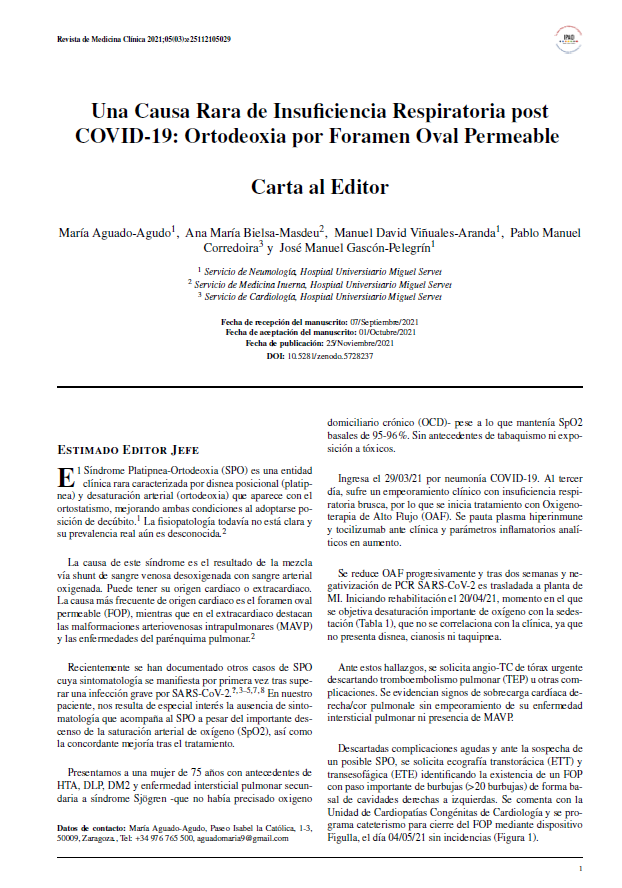Resumen
En relación con la pandemia actual del SARS-CoV-2, se han documentado casos de Síndrome de Platipnea Ortodeoxia (SPO) cuya sintomatología se ha puesto de manifiesto una vez pasada la infección aguda por COVID-19. Este síndrome se caracteriza por disnea posicional acompañada de una importante desaturación arterial de oxígeno al adoptar posición de ortostatismo, remitiendo la sintomatología al volver a posición de decúbito. Su fisiopatología es aún un misterio, aunque la causa más documentada es la cardiaca -debido a la existencia de un foramen oval permeable (FOP)-. Presentamos el caso de una paciente de nuestro hospital que, tras pasar la infección por SARS-CoV-2, debutó con SPO y en el que el diagnóstico oportuno permitió corregir la causa y devolver a la paciente su calidad de vida previa.
Referencias
Burchell HB, Helmolz HF Jr, Wood EH. Reflex orthostatic dyspnea associated with pulmonary hypotension. Am J Physiol. 1949; 159:563-4.
Agrawal A, Palkar A, Talwar A. The multiple dimensions of Platypnea-Orthodeoxia syndrome: A review. Respir Med. 2017;129:31–8
Vanhomwegen C, Taton O, Selvais N, Vanhove O, Leduc D. Patent foramen ovale revealed by COVID-19 pneumonia. BMC Pulm Med. 2021;21(1):1–4.
Longo C, Ruffini L, Zanoni N, Longo F, Accogli R, Graziani T, et al. Platypnea-orthodeoxia after fibrotic evolution of SARS-CoV-2 interstitial pneumonia. A case report. Acta Biomed. 2020;91(3):1–7.
Tan GP, Ho S, Fan BE, Chotirmall SH, Tan CH, Lew SJW, Chia PY, Young BE, Abisheganaden JA, Puah SH. Reversible platypnea-orthodeoxia in COVID-19 acute respiratory distress syndrome survivors. Respir Physiol Neurobiol. 2020 Nov;282:103515
Singh K, Kadnur H, Ray A, Khanna P, Singh A, Wig N, et al. Platypnea-orthodeoxia in a patient with severe COVID-19 pneumonia. Monaldi Arch Chest Dis. 2020;90(4):718–20.
Corrêa PC. On the case report of platypnea-orthodeoxia after SARSCoV-2 pneumonia plus historical notes. Acta Biomed. 2020;91(4):1–2.
Tham S, Ong P, Lee A, Tay M. Rehabilitation of patients with platypnea-orthodeoxia syndrome in COVID-19 pneumonia: Two case reports. J Rehabil Med – Clin Commun. 2020;3(1):1-5.
Yepes I, Ji S, Wu F, Tijmes S, Roberts J. Platypnea-Orthodeoxia Syndrome: Rare or Under-Diagnosed Syndrome? 3 Case Reports and a Literature Review. Cardiovasc Revascularization Med. 2021;22(xxxx):115–9.
Layoun ME, Aboulhosn JA, Tobis JM. Potential role of patent foramen ovale in exacerbating hypoxemia: In chronic pulmonary disease. Texas Hear Inst J. 2017;44(3):189–97.
Sabater Abad C, Juan Samper G, Payá Serrano R, Pérez Boscá JL, Ramón Capilla M, Fernandez Fabrellas E. Síndrome platipnea-ortodeoxia cardiaco: una causa «misteriosa» de hipoxemia. Archivos de Bronconeumología. 2016;52(9):494-5.
Cheng TO. Mechnisms of platypnea-orthodeoxia: What causes water to flowuphill? Circulation. 2002;105:e47.
Tarrasó Castillo J, Posadas Blázquez TJ, Lahosa Córdoba C, Signes-Costa J. COVID-19: New disease, new manifestations. Arch Bronconeumol. 2020 Dec;56(12):825-26
Calvert PA, Rana BS, Kydd AC, Shapiro LM. Patent foramen ovale: Anatomy, outcomes, and closure. Nat Rev Cardiol. 2011;8(3):148–60.
Siswanto, Gani M, Fauzi AR, Yuliyanti RE, Inggriani MP, Nugroho B, et al. Possible silent hypoxemia in a COVID-19 patient: A case report. Ann Med Surg. 2020;60(October):583–6.
Tobin MJ, Laghi F, Jubran A. Why COVID-19 Silent Hypoxemia Is Baffling to Physicians. Am J Respir Crit Care Med. 2020;202(3):356-60
Brito-Azevedo A, Pinto EC, de Cata Preta Corrêa GA, Bouskela E. SARS-CoV-2 infection causes pulmonary shunt by vasodilatation. J Med Virol. 2021;93(1):573–5.
Salazar C, Blank JB, Palmero V. Orthodeoxia without Platypnea in Hereditary Hemorrhagic Telangiectasia in the Presence of a Cerebral Abscess and Multiple Pulmonary Arteriovenous Malformations: Unusual Complications and Transcatheter Endovascular Treatment. Case Rep Pulmonol. 2017;2017:1–4.
Santhirapala V, Chamali B, McKernan H, Tighe HC, Williams LC, Springett JT, et al. Orthodeoxia and postural orthostatic tachycardia in patients with pulmonary arteriovenous malformations: A prospective 8-year series. Thorax. 2014;69(11):1046–7.
Santhirapala V, Williams LC, Tighe HC, Jackson JE, Shovlin CL. Arterial oxygen content is precisely maintained by graded erythrocytotic responses in settings of high/normal serum iron levels, and predicts exercise capacity: An observational study of hypoxaemic patients with pulmonary arteriovenous malformations. PLoS One. 2014;9(3):1–11.

Esta obra está bajo una licencia internacional Creative Commons Atribución-NoComercial-SinDerivadas 4.0.
Derechos de autor 2021 María Aguado Agudo, Ana María Bielsa-Masdeu, Manuel David Viñuales-Aranda, Pablo Manuel Corredoira, José Manuel Gascón-Pelegrín

